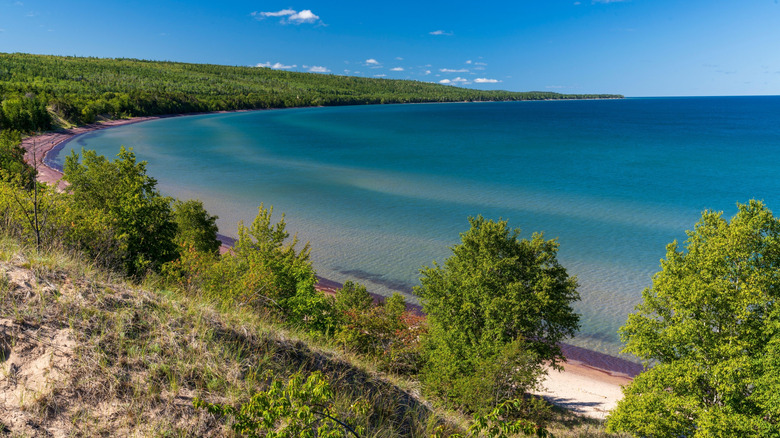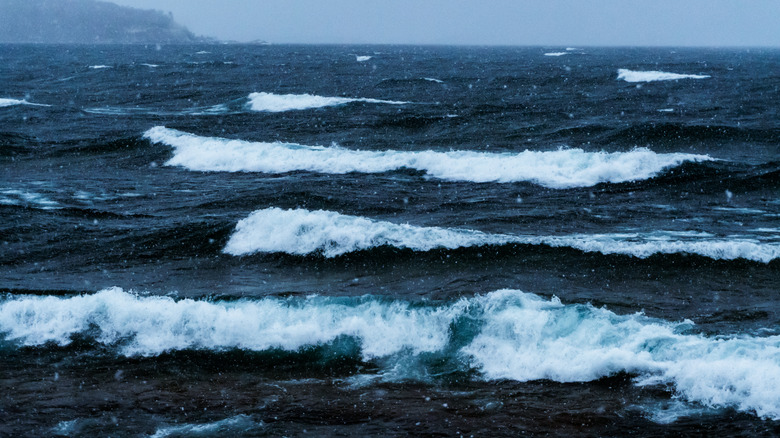The Great Lakes Don't Technically Have Tides Like The Ocean, Here's Why
Roughly 3,000 feet off the coast of mainland France in Normandy lies Mont-Saint-Michel abbey, a stately castle-like structure originally built in the 8th century on a granite outcropping that rises 256 feet from the sea bottom into the sky. The only way to reach the fortified building is via a causeway — except for the two times of the day when the sea seems to magically vanish, leaving a vast sandy wet plain where there were several dozen feet of water moments ago.
Mont-Saint-Michel is famous for this disappearing act, and it owes much of its tourist-destination allure to the unique force that makes it such a special place — the tides. Tides on Earth are caused by the gravitational pull of the moon (and to a much lesser extent, the sun). As the Earth rotates, the side of the planet that approaches the moon experiences a gravitational pull that affects the water directly beneath it (and the solid Earth, too, just not as noticeably). This creates a "bulging" effect on two opposite sides of the planet, a phenomenon that we call "high tide." When the Earth rotates past the moon, the tide recedes. Because of this gravitational dance, coastal areas the world over experience two high tides and two low tides roughly every 25 hours.
But not the Great Lakes. Despite being the largest inland bodies of water on the North American continent and comprising the vastest freshwater system on Earth, the Great Lakes are strangely devoid of tidal action. But how is this possible? The water level in the Great Lakes does indeed fluctuate, so what could be acting on it? The answer reveals some fascinating dynamics about weather and climate conditions around the lakes and how they shape their existence.
Why the Great Lakes water levels change
While the Great Lakes do experience minor tidal fluctuations due to the gravitational pull of the moon and the sun, these changes are relatively minuscule — typically less than 2 inches — and are often overshadowed by more significant meteorological factors. Wind patterns and atmospheric pressure variations play a more substantial role in altering water levels, leading to phenomena known as seiches. Seiches are waves that oscillate and cause water levels to rise or fall several feet over the course of up to 14 hours, which is why they are often mistaken for tidal action. And, just like in ocean intertidal environments, the animals and plants in Lake Superior, the largest of the Great Lakes, are adapted to these changing conditions.
The Great Lakes experience seasonal variations, too. Increased precipitation and melting snow contribute to higher levels in June, while reduced inflow in the winter drops levels by several feet. More long-term differences can be seen as a result of changes in climate patterns. So, given the minimal impact of gravitational tides and the dominance of weather and climate-related factors, the Great Lakes are classified as non-tidal bodies of water. The water levels on the Great Lakes continue to change with time, as well. From the late 19th century until just recently, the water levels were on a slow decline, but as of 2023, these levels were just above average.
Lakes around the world reflect changes in weather and climate patterns, which is one of the reasons why scientists monitor them. Sometimes these changes can be quite drastic. California's Tulare Lake keeps disappearing for decades at a time, for example. And occasionally, humanity's fascination with lakes can turn lethal, as is the case with the unassuming New Mexico lake that's actually a deathtrap.

